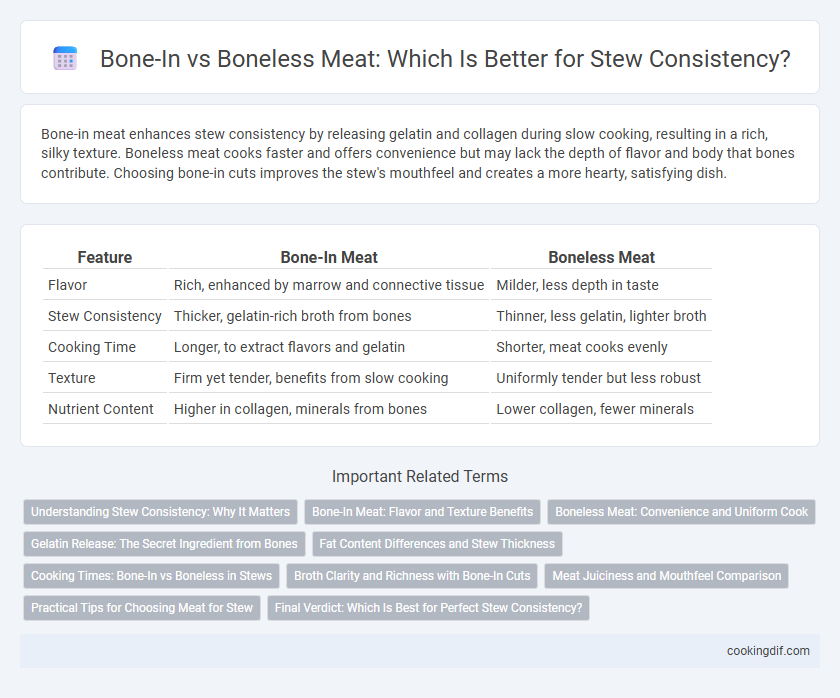Bone-in meat enhances stew consistency by releasing gelatin and collagen during slow cooking, resulting in a rich, silky texture. Boneless meat cooks faster and offers convenience but may lack the depth of flavor and body that bones contribute. Choosing bone-in cuts improves the stew's mouthfeel and creates a more hearty, satisfying dish.
Table of Comparison
| Feature | Bone-In Meat | Boneless Meat |
|---|---|---|
| Flavor | Rich, enhanced by marrow and connective tissue | Milder, less depth in taste |
| Stew Consistency | Thicker, gelatin-rich broth from bones | Thinner, less gelatin, lighter broth |
| Cooking Time | Longer, to extract flavors and gelatin | Shorter, meat cooks evenly |
| Texture | Firm yet tender, benefits from slow cooking | Uniformly tender but less robust |
| Nutrient Content | Higher in collagen, minerals from bones | Lower collagen, fewer minerals |
Understanding Stew Consistency: Why It Matters
Bone-in meat contributes collagen and gelatin during slow cooking, enriching stew consistency with a silky, full-bodied texture. Boneless meat cooks faster but lacks the natural thickening agents found in bones, often resulting in a thinner, less robust stew. Understanding these differences helps achieve the desired mouthfeel and richness critical for authentic, hearty stew preparation.
Bone-In Meat: Flavor and Texture Benefits
Bone-in meat enhances stew consistency by releasing collagen and marrow during slow cooking, enriching the broth with a deep, savory flavor and a silky texture. The presence of bones helps retain moisture in the meat, resulting in tender, juicy pieces that improve the overall mouthfeel of the stew. Slow-cooked bone-in cuts like short ribs and oxtail create a richer, more gelatinous stew base compared to boneless alternatives.
Boneless Meat: Convenience and Uniform Cook
Boneless meat offers enhanced convenience and promotes uniform cooking in stews, ensuring even heat distribution and consistent texture throughout the dish. Without bones, the meat cuts more easily into bite-sized pieces, allowing faster absorption of flavors and tenderizing during the stewing process. This results in a stew with a smooth, cohesive consistency and balanced taste in every spoonful.
Gelatin Release: The Secret Ingredient from Bones
Bone-in meat enhances stew consistency through gelatin release, which occurs as collagen in bones and connective tissues breaks down during slow cooking. This natural gelatin thickens and enriches the stew, providing a silky texture and robust mouthfeel that boneless meat cannot replicate. Using bone-in cuts like short ribs or shanks ensures a deeply flavorful and perfectly balanced stew with ideal viscosity.
Fat Content Differences and Stew Thickness
Bone-in meat typically contains more fat and connective tissue, which melts during cooking to enhance stew richness and natural thickness. The marrow within bones releases gelatin, contributing to a silky, thicker consistency that boneless cuts often lack. Boneless meat stews may require added fats or thickeners to achieve a comparable depth and mouthfeel in the broth.
Cooking Times: Bone-In vs Boneless in Stews
Bone-in meat requires longer cooking times in stews to allow collagen and marrow to break down, enriching the broth with deeper flavors and a silkier texture. Boneless meat cooks faster, making it ideal for quick stews but often results in a less robust consistency and lighter broth. Choosing bone-in cuts like beef shanks or short ribs enhances stew richness through extended simmering, while boneless cuts such as stew beef or chuck facilitate faster meal preparation.
Broth Clarity and Richness with Bone-In Cuts
Bone-in meat significantly enhances stew consistency by releasing collagen and marrow, which enrich the broth with a deeper, fuller flavor and improved mouthfeel. The gelatin from bones contributes to a thicker, more luxurious texture, while also promoting broth clarity by gently simmering impurities away. This results in a rich, savory stew with a clear, hearty broth that boneless cuts often fail to achieve.
Meat Juiciness and Mouthfeel Comparison
Bone-in meat enhances stew juiciness by releasing collagen and marrow during slow cooking, enriching the broth with deep, savory flavors and a silky mouthfeel. Boneless meat cooks faster and offers a more uniform texture, but it may lack the rich, gelatinous quality that bone-in cuts provide. Choosing bone-in cuts like short ribs or shanks maximizes stew richness and creates a velvety, satisfying bite.
Practical Tips for Choosing Meat for Stew
Bone-in meat enhances stew consistency by releasing collagen and marrow during slow cooking, resulting in a richer, gelatinous texture that thickens the broth naturally. Boneless meat offers convenience and quicker cooking times but may require additional thickening agents to achieve the desired stew consistency. For optimal stew results, select bone-in cuts like beef shanks or short ribs to maximize flavor and body, especially in recipes requiring extended simmering.
Final Verdict: Which Is Best for Perfect Stew Consistency?
Bone-in meat delivers richer flavor and gelatin, enhancing stew's texture and thickness through slow cooking. Boneless meat softens quickly, offering convenience but often lacks the depth and body bones impart. For perfect stew consistency, bone-in cuts provide superior richness and mouthfeel, making them the best choice.
Bone-In Meat vs Boneless Meat for stew consistency Infographic

 cookingdif.com
cookingdif.com